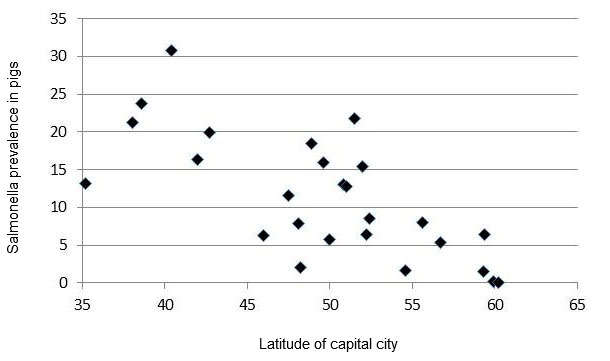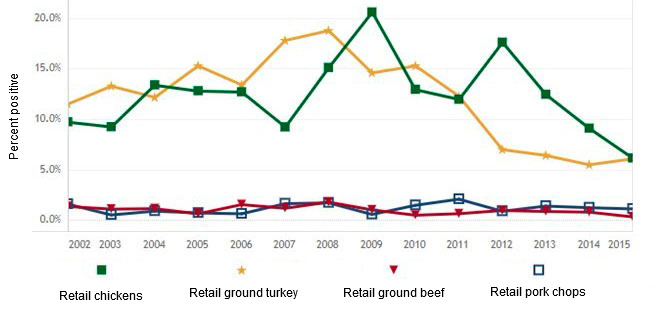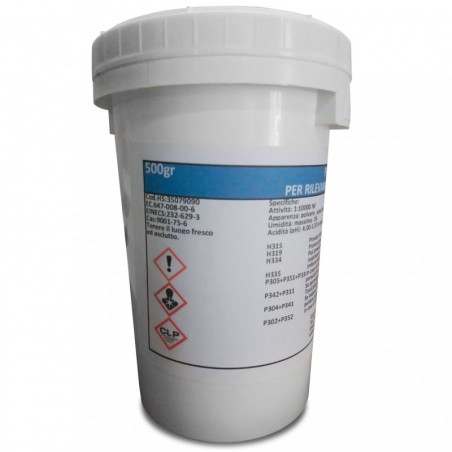|
‘Attempting to unravel the epidemiology of Salmonella infections in both humans and animals continues to provide employment for many health professionals – there is little to suggest that a magic bullet is on the horizon’ Professor Ashley Robinson, University of Minnesota, 1996  |
In 1993, meat borne disease outbreaks on both sides of the Atlantic fueled concerns about the efficacy of traditional meat inspection systems for protecting consumers from foodborne pathogens (Davies, 1997). The ‘farm to table’ concept, in which all participants in food production and consumption bear responsibilities to reduce risks, emerged as the dominant paradigm for combatting foodborne diseases. These outbreaks catalyzed the implementation, in 1995, of a national Salmonella control program (NSCP) in swine in Denmark; and in the USA, in 1996, the passage of the HACCP/Pathogen Reduction Act (PRA). The PRA legislation clarified the responsibility of slaughter plant management to ensure compliance with sanitation requirements; 2) established enforceable requirements for prompt chilling of carcasses and parts; 3) established targets for pathogen reduction and daily microbial testing; and 4) required establishments to develop, adopt, and implement a HACCP system to improve the safety of their products.
A key distinction between the NCSP (and analogous programs in other EU countries) and the PRA in the USA lay in the in emphasis given to preharvest control. Serological testing of all herds to identify ‘high risk’ herds for intervention was the centerpiece of the NCSP in Denmark (Mousing et al., 1995). In contrast, the PRA did not address preharvest control, but focused on improving processes in the harvest sector (also part of the Danish program). The likely wisdom of that decision lay in the fact that epidemiologic knowledge about bacterial foodborne hazards in animal populations was inadequate to enable reliable and cost-effective control measures to be mandated on farms.
Although preharvest control to exclude Salmonella from animal populations has long been employed in Sweden (Sundstrom et al., 2014), this expensive and resource-intensive approach has not been adopted in any major swine producing country. The feasibility (and relative costs and benefits) of different approaches depends on the epidemiological circumstances in each country or region (Dahl, 2013), which may be influenced by macro-climatic factors. In Europe, the latitude of capital cities explains over 50% of the variance among EU countries in prevalence of Salmonella in swine mesenteric lymph nodes of pigs estimated in the EFSA baseline study (Figure 1), and studies in the southern hemisphere have also observed highest prevalence at lower latitudes (Hamilton et al, 2001; Vico et al., 2015).
Preharvest control efforts to control (rather than exclude) Salmonella in swine farms, based on serological testing, with interventions for high seroprevalence herds, have not yet delivered encouraging outcomes (Davies, 2011; Dahl, 2013). The greatest hurdle to pre-harvest control remains the lack of validated and reliable management interventions.

After over 20 years of research effort, the question of how to balance efforts in Salmonella control among the preharvest, harvest, and post-harvest sectors remains alive, but ‘silver bullets’ for on-farm control of Salmonella in pigs have proven elusive. Recently, a UK study of 5 interventions (vaccination, movement to an outdoor breeding unit, improved cleaning and disinfection, fermented liquid feed, and organic acids) to control Salmonella on swine farms concluded that none were cost effective for UK economy (Simmons et al, 2017).
In contrast, improvements in slaughter hygiene have proven a reliable and cost-effective alternative. In the USA, in 2009, Salmonella prevalence on carcasses at large packing plants (which process a large proportion of pork products in the United States) was 1%, less than one-eighth of the baseline prevalence (8.7%) in the mid-1990s (Davies, 2011). Also, ongoing surveillance of Salmonella prevalence in retail meats indicate consistently low prevalence for pork chops (Figure 2), although prevalence in pig caecal samples remains consistently high (FDA, 2016). This progress has been achieved without any specific efforts to control Salmonella on farms, although substantial management changes have occurred in the industry over that time. In countries where Salmonella contamination of meat products is problematic, efforts directed to post-harvest activities should have the highest priority, including emphasis on slaughter hygiene and avoidance of time-temperature abuse in the distribution, retail and consumer segments. Preharvest control of enteric foodborne bacteria remains the ‘holy grail’ but has proven neither simple nor cheap and is limited by the paucity of validated and cost-effective interventions.






